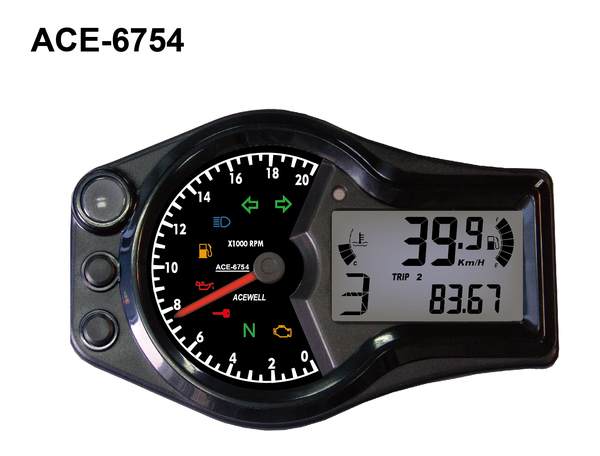Tachometer Basics: Every Little Thing You Need to Know for Accurate Readings
Tachometer Basics: Every Little Thing You Need to Know for Accurate Readings
Blog Article
Discovering the Functions and Benefits of a Tachometer: A Comprehensive Guide for Automobile Enthusiasts
In the realm of automobile instrumentation, the tachometer stands as a necessary device that supplies drivers important understandings into their automobile's efficiency. tachometer. From offering real-time information on engine speed to assisting in optimizing gear shifts, the tachometer works as greater than just a dial on the control panel. Its multifaceted functions not just boost driving experience yet likewise play a critical duty in keeping engine health and wellness and efficiency. As we explore the intricate operations and benefits of a tachometer, a much deeper understanding of its importance for car fanatics and specialists alike will unravel.
Recognizing the Basics of a Tachometer
In the world of automotive instrumentation, recognizing the essentials of a tachometer is important for any automobile lover aiming to look into the ins and outs of engine performance monitoring. A tachometer, often shown on the dashboard of an automobile, determines the engine's revolutions per minute (RPM) This critical tool offers real-time data on how fast the engine crankshaft is rotating. By keeping an eye on the RPM, chauffeurs can ensure they are operating within the ideal range to optimize efficiency and effectiveness.
Tachometers normally have actually a range noted in changes per min, with a redline suggesting the maximum rate at which the engine can safely operate (tachometer). This information is important for protecting against engine damages and maximizing gear moving for manual transmissions. Additionally, tachometers can assist in diagnosing engine issues such as misfires or a falling short ignition system by identifying irregular RPM readings
Relevance of Checking Engine Speed

Monitoring engine rate is a critical facet of automobile upkeep and performance optimization for auto enthusiasts and specialists alike. The engine speed, gauged in transformations per min (RPM), suggests how quick the engine's crankshaft is revolving. By keeping a close eye on the RPM, chauffeurs can ensure that the engine is running within the ideal array, stopping possible damage from over-revving or stalling. Checking engine rate is specifically important during gear changes, as it helps motorists determine the correct time to alter gears for smooth acceleration and efficient fuel consumption.
Additionally, tracking engine speed can additionally offer important insights right into the overall health and wellness of the lorry. Unusual changes in RPM might indicate issues such as a clogged air filter, fuel system issues, or also engine misfires. By discovering these problems early via the tachometer analyses, vehicle drivers can address potential concerns immediately, preventing more extreme damage and expensive repair services down the line. In general, keeping an eye on engine rate with a tachometer is a basic practice that can improve driving efficiency, extend engine life, and ensure a more secure and extra satisfying driving experience.
Enhancing Performance With Gear Shifts
Optimizing performance through strategic gear shifts is a crucial facet of making the most of a lorry's efficiency and power output. Appropriate equipment changing makes sure that the engine runs within its ideal power band, permitting smooth velocity and enhanced gas economy. When changing gears, it is important to pay attention to the engine speed showed on the tachometer. By keeping track of the engine revolutions per minute (RPM), motorists can establish the most opportune minutes to upshift or downshift for optimal performance.

To attain peak performance with gear shifts, chauffeurs must exercise smooth and prompt transitions between gears, matching engine speed with road speed to harness the full capacity of their automobile's powertrain.
Taking Full Advantage Of Performance With a Tachometer
Understanding the art of equipment changing in high-performance lorries not just boosts driving experience yet additionally plays an important function in taking full advantage of effectiveness with a tachometer. tachometer. By paying close interest to the tachometer analyses, motorists can enhance their gear shifts to operate within the engine's most efficient array. When increasing, changing equipments at the ideal RPM suggested by the tachometer can avoid the engine from overworking or underperforming, resulting in improved gas performance and general performance
Additionally, a tachometer helps vehicle drivers stay clear of unnecessary revving, which not only throws away gas however also places unneeded strain on the engine. Consistently keeping an eye on the tachometer while driving enables for smoother gear changes, minimizing deterioration on the transmission system over time.

Advanced Tips for Tachometer Utilization
To delve into advanced pointers for tachometer application, think about integrating the use of shift lights. Shift lights are visual signs that brighten when it's time to shift gears based on engine revolutions per min (RPM), enabling for seamless gear modifications without frequently monitoring the tachometer. By fine-tuning change points and setting warning limits, vehicle drivers can enhance acceleration and engine performance while decreasing the danger of over-revving.
Final Thought
In conclusion, the tachometer works as a critical device for automobile enthusiasts see this to check engine rate, enhance efficiency with gear changes, and make the most of efficiency. By recognizing the functions click resources and advantages of a tachometer, motorists can optimize their driving experience and lengthen the lifespan of their lorry. Using innovative ideas for tachometer use can further boost driving skills and general performance when driving.
Report this page